Welcome to the LWMGA Rules and Etiquette Picture Gallery
Sometimes it is difficult to get a picture in your minds eye of
what is
being discussed and ruled upon. Hopefully this site will help you
visualize rules and/or etiquette violations that you may encounter
during a golf outing or
tournament. The discussions here will be derived from the USGA Rules of
Golf.
a) Grounding club
Ground under repair
I'm sure if you haven't found yourself in an area of "ground under
repair" you will if you continue to play golf. Areas designated as
"ground under repair" are marked by the course professional prior to a
tournament or event with white paint. An example of such an area is
shown here at Holmes Golf Course. Clearly the grass is missing and the
area is bare dirt and has been designated as "ground under repair". 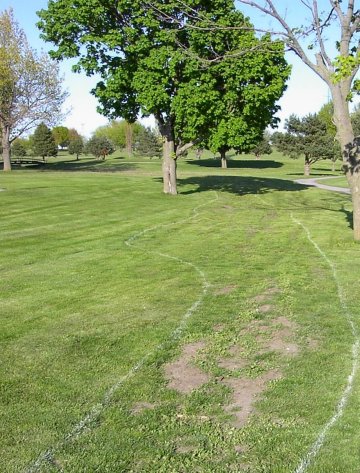
OK, now that we know what to look for. How do we handle the issue if we
find ourselves there in the future. Well, here I am with just such a
problem. 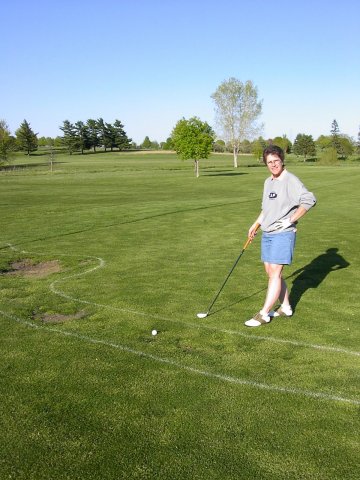 My
ball has come to rest within a "ground under repair" marked area. I
have a few options but a few issues
need to be addressed. First, I must take FULL relief from the area.
What do we mean by FULL relief? Not only does the ball need to be
removed from the area with a drop but when I take my stance after the
drop, no part of my body (feet in particular) can be touching the area.
This is one area where
we do not have the option to play it even if we want to. We MUST
take a drop.
My
ball has come to rest within a "ground under repair" marked area. I
have a few options but a few issues
need to be addressed. First, I must take FULL relief from the area.
What do we mean by FULL relief? Not only does the ball need to be
removed from the area with a drop but when I take my stance after the
drop, no part of my body (feet in particular) can be touching the area.
This is one area where
we do not have the option to play it even if we want to. We MUST
take a drop.
Here I have taken my drop and the ball lies outside the "ground under
repair". But I'm still in violation of
the rule because my stance when preparing to hit the ball
still has my feet clearly inside the marked area. Because I have not
taken FULL relief from the marked area, I'll need
to redrop the ball further from the area but no closer to the hole.
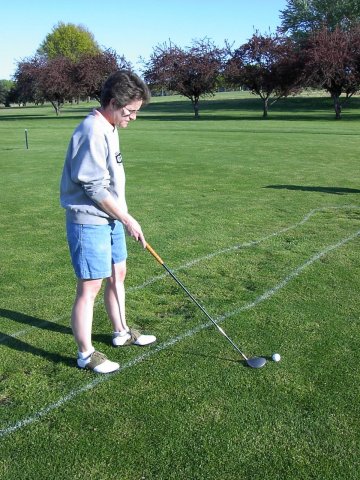
After making a second drop, I can now take my normal stance to hit the
ball without encroaching on the "ground under repair". Play can now
continue and hopefully I will manage to stay away from more trouble.
But if I find myself here again....I will know how to handle it.
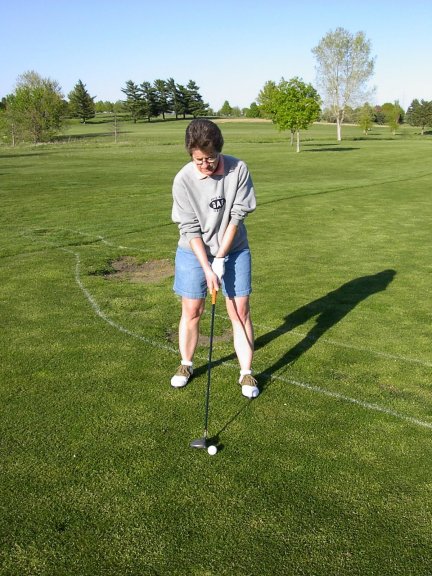
Knowing the Rules of Golf will only help you appreciate the complete
game of golf.

Drop Zone
The drop
zone is a marked area which can be found on par 3s and sometimes is
found near water hazards. A drop zone is used if a ball is hit into
water or an area where it can not be retrieved.
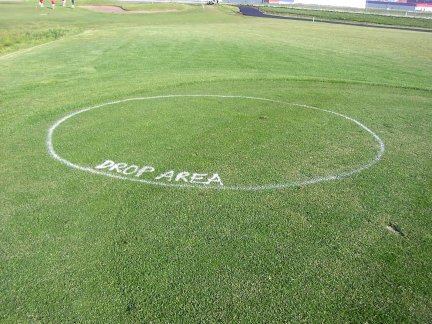
This drop zone was marked on Highlands #12 a par 3 with a water hazard
just off to the left of the green. If after teeing off the players ball
manages to fall in the water the player must take a stroke penalty and
redrop in the marked area.
Unless otherwise stated the player could also choose to retee and hit
from the tee box. But when hitting their second ball the player is
hitting their 3rd shot. 
Trap
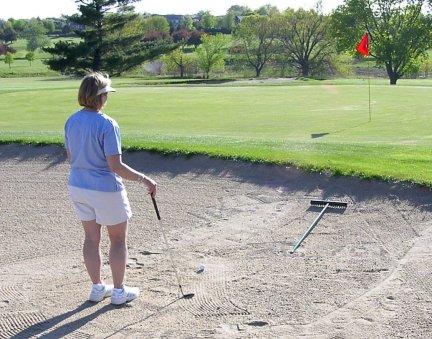 a) Grounding your club in a
trap is a no no. Doing so will be a two stroke penalty in Stroke Play.
a) Grounding your club in a
trap is a no no. Doing so will be a two stroke penalty in Stroke Play.
You are not permitted to touch the sand with your club prior to making
contact with your down swing towards the ball. So take care. 
Teeing it up
When we get ready to
tee off on a hole it is important to know that you have more room than
you might think. First and foremost it should be remembered that you
MUST tee up your ball behind the
designated tee markers, and not as we see here. Cheryl informs Karen
that she has mistakenly teed up in front of the markers
and needs to move behind so as not to encure a penalty. Karen
has up to 2 club lengths behind the markers to tee up her ball and has
illustrated that here. In addition, a player's ball is required
to be placed between markers BUT the player is allowed to stand
outside the markers to hit the shot.
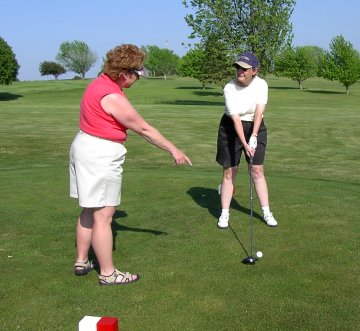
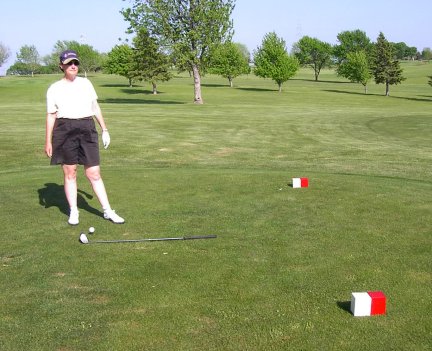

Unplayable Lie
I'm sure, at one time or
another, we have all found ourselves in a situation where we could not
make a shot.
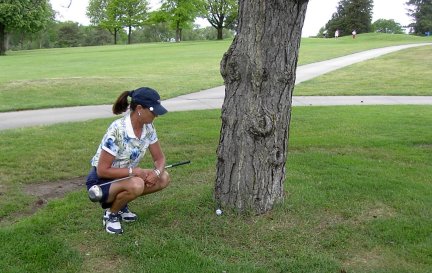
Here we find Deb evaluating the possibilities for her next shot.
Options:
1) she can keep the point where the ball lies between her and the flag,
and go back as far as she wants and then make her drop. In Deb's case
however, she has a lake just behind the tree and can not go back far
enough to get a shot over the pine tree. Next option:
2) she can take two club lengths from the position of the ball and
place a tee. Then she can make her drop and continue play.
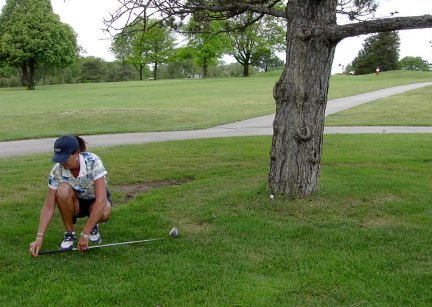
Below we see the correct way to drop a ball. Hold the ball out at 90
degrees from
your body and let it drop. The ball should hit within the two
club lengths you measured and marked with a tee.
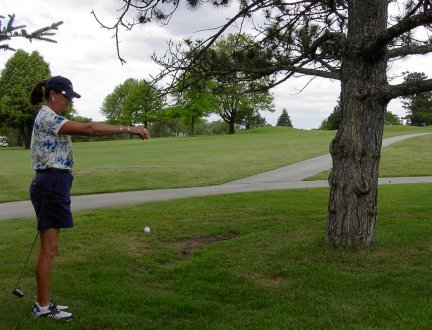
Deb can now continue play hitting her 3rd shot.
How do you score this process?
Tee shot landed at the base of the tree......stroke 1.
Declare the ball unplayable,
take one stroke penalty, and make your drop.....stroke 2. You are now
ready to continue play and are hitting your
3rd shot.
Fairway obstruction
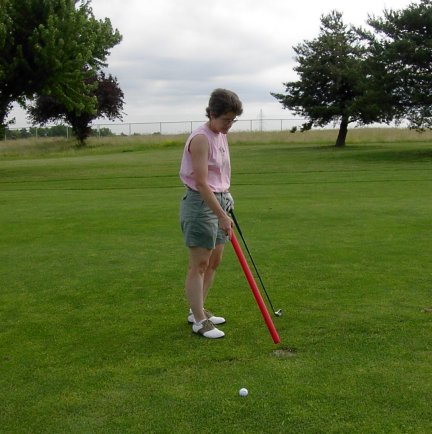 Have you ever come upon your shot in the
fairway and found one of the distance markers so close to your ball
that
you can not take proper stance for the next shot? Here was just
a case when the 100 yard stake kept me from taking a normal stance
for my shot.
Have you ever come upon your shot in the
fairway and found one of the distance markers so close to your ball
that
you can not take proper stance for the next shot? Here was just
a case when the 100 yard stake kept me from taking a normal stance
for my shot.
The Rules of Golf allow for such an occasion. This is considered an
obstruction and you have the right to remove the stake and lay
it out of the way.
But in my case, the stake had been placed in a concrete
block that was right where my foot would be when setting up for the
shot to the green. In this case, I am allowed to take further relief
from the continued obstruction.
Mark your ball with a tee and lift the ball. Take your stance at a
point that will give you complete relief from the concrete block but is
no nearer the hole. Once this point is determined you have one
club length to drop the ball. Your ball is now back in play and no
penalty strokes are incurred.
It pays to know the rules, because as in this case, I was
benefited by knowing the rules of golf.
Be sure to replace the red marker when you have completed your shot.
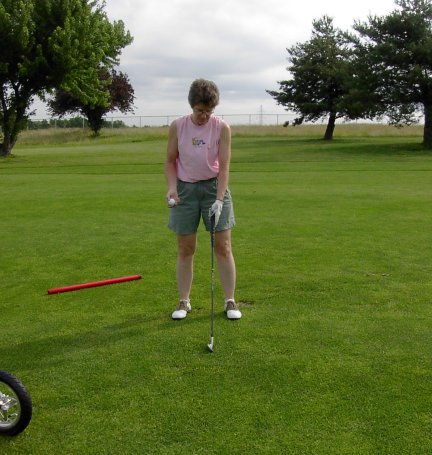
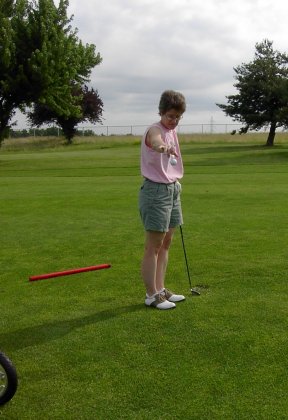

Water hazard
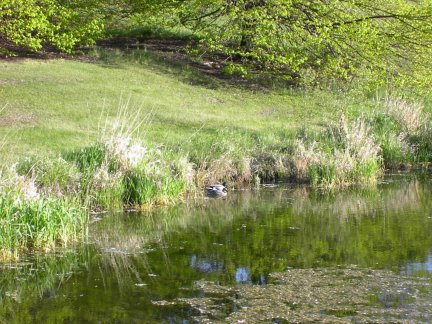
Here is a lovely scene that can be found on any number of golf courses
in the area.
But if your like me, it also brings to mind....yellow or red hazard.
What is the difference? Do I have the same options for both? Just the
fact there are two kinds of water hazard, yellow and red, should tell
you that there are some differences with our options when we find
ourselves in one or the other.
Water hazards are usually marked by yellow or red stakes depending on
which they may be. If no stakes are present then look for a painted
yellow or red line just outside the hazard area. This line is
considered IN the hazard so if your ball is touching or lying on the
line, YOU ARE IN THE HAZARD.
What now. First determine which hazard you are in.
Water hazards, other than lateral water hazards, are defined by
yellow stakes.
Lateral water hazards are defined by red stakes.
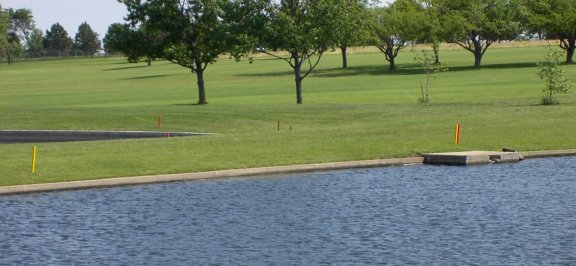
It can be confusing at times to know under which hazard condition
you are in but keep a cool head and know your options.
Below we see an unfortunate player who has determined that her ball has
reached the water hazard. From the yellow stakes she knows she is under
the condition of water hazard and has three options from which to pick
for her drop.
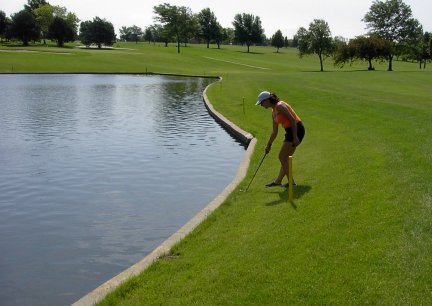
1) If she can see her ball and get to it, she can go ahead and play the
ball as it lies without penalty, keeping in mind you can not ground
your club in the hazard,
2) If the ball is not playable, then imagine a line from the hole
through the point where the ball last crossed the margin of the hazard.
Under penalty of one stroke, she can go back as far as she would want
and drop.
3) Or she can always take loss of stroke and distance or in effect, go
back to the spot where the original ball was struck and play her next
shot.
How do you count the strokes? If her original ball was a tee shot that
entered the water, then her next shot would be her third if she
selected option 2 or 3. She would be hitting 2 if she was able to play
out of the hazard itself.
So what are our options from a Lateral Water Hazard?
We have five options with a lateral water hazard, the same three from a
regular water hazard listed above as well as two additional options:
4) we can drop within two club lengths from the point where it entered
the hazard no closer to the hole and hit under a penalty of one stroke,
or
5) we can hit from the opposite side of the hazard, where the reference
point is the same distance from the hole as the point at which the ball
originally entered the hazard, drop within two club lengths no nearer
the hole.

Manning the Flag
To keep play moving, the first person to hole out on a green should
move to the flag and man it while the rest of the group finishes
putting out. This is commonly done as a courtesy to the rest of the
group. If however your group is falling behind, the first two players
to hole out on a hole should move to the next hole and tee off while
the remaining two players hole out . This will help your group get back
into good
contact with the group in front.
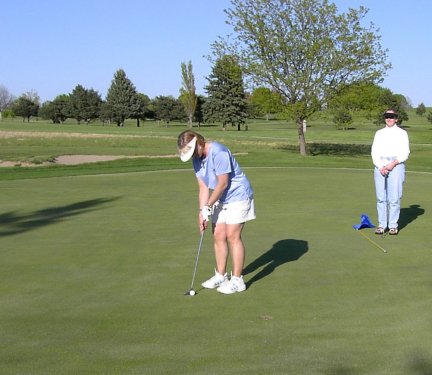

Marking your ball
One of the simplest rules of golf is one that seems to be hardest for
some players to grasp. The act of marking your ball once you reach the
green surface. , Basically we as players are not allowed to touch our
ball before it reaches the green under normal circumstances. Of course
we can all think of exceptions but for now lets just concentrate on the
simple act. 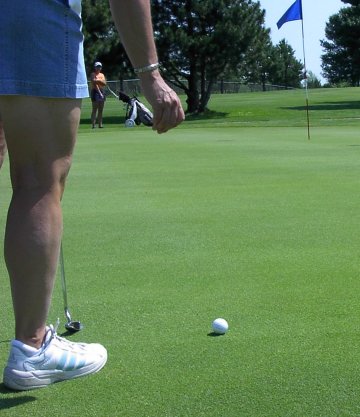 Once the ball has come to rest
on the green, you must place a marker behind the ball when it has
finally come to rest on the green. But do not touch the ball until you
have placed your mark behind the ball. Then and only then can you lift
your ball.
Once the ball has come to rest
on the green, you must place a marker behind the ball when it has
finally come to rest on the green. But do not touch the ball until you
have placed your mark behind the ball. Then and only then can you lift
your ball.
A ball marker can be a number of things, for example a ball marker,
coin, tee, or anything else that will not move
but still mark your position. Below is an example of the placement
of a marker behind the ball. 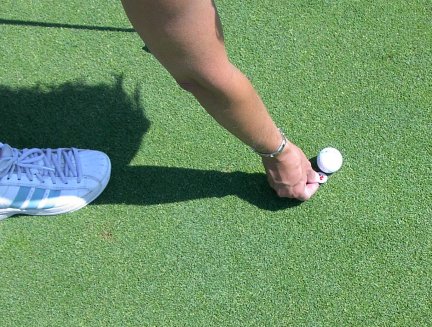 Here we see
the player placing their marker behind the ball BEFORE they have lifted
the ball. Once it is in place the
player can legally lift and clean their ball.
Here we see
the player placing their marker behind the ball BEFORE they have lifted
the ball. Once it is in place the
player can legally lift and clean their ball.
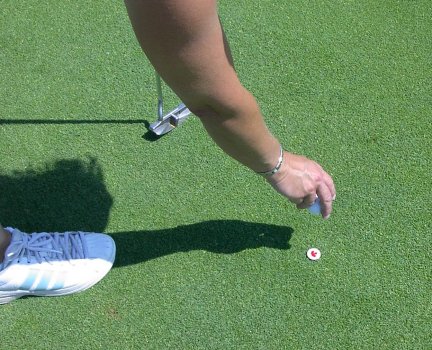

Repairing your divot
Have you ever walked onto a green and seen all the ball divot marks and
muttered "why can't people repair their marks so the rest of us can
have a clean putting surface"? Well, I know I have and I bet you
have too. So for those new to the game, here is a simplified
description of the act of repairing your ball marks after they have
landed on the green surface. If you have hit a nice shot into a green
the likelihood of the ball leaving a mark is good. So do the rest of
the golfing
public the courtesy of repairing your mark. A divot repair tool can
be purchased from any course for a couple dollars. It looks like a
little tuning fork. Once you have located your divot, insert the tool
about 1/4" outside the divot hole and lift towards the center. Repeat
this a few times moving around the divot. You will notice that the hole
slowly is closed off by the slight movement of the turf. Then tap the
raised grass with your putter to smooth the area. This allows the green
to heal much faster, and will provide a smooth surface for all those
golfers following you. And from me to you.....THANK YOU!!
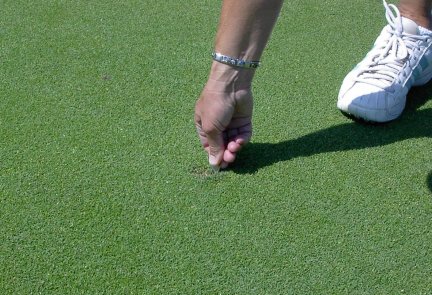
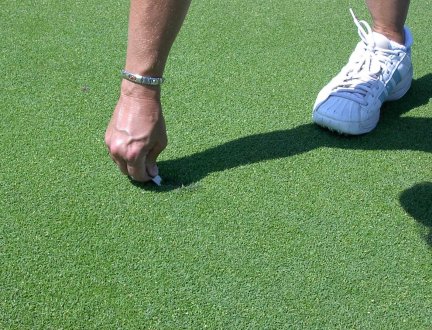
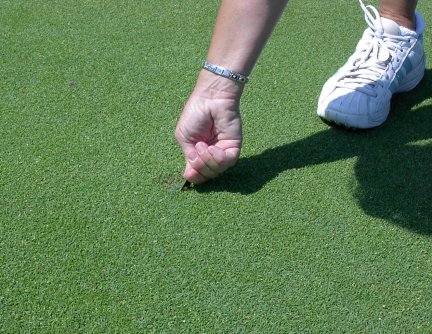
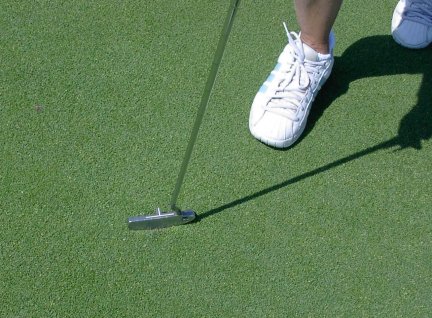

Lost Ball and Unplayable
I feel that several of us hate to admit there have been times when we
miss the fairway.....right? And, a few more times when we REALLY
miss the fairway. So how do we handle the possibility of not
being able to locate a ball. And, what if we DON'T want to find
the original ball? Are these all viable options for us to
consider? Well, believe it or not yes and hopefully I can explain
the process we must consider when dealing with these situations and
what rules are being invoked to make sure we log the correct score on
the scorecard and avoid disqualification for signing an incorrect
scorecard.
OK, this is COMPLETELY hypothetical.....no.....really......it is.....ha
ha.
I arrive on the tee box at #11 at Holmes and hit a "lovely" duck hook
into the tall fescue grass growing just off the second cut of
rough. First, since the grass is taller than I and the likelihood
of my getting out of this "lovely fall grass" (right....what have
I been smoking huh) let alone finding the ball is in question.
So, to save time, declare to your playing partners that you will hit a
provisional ball from the tee box before going to hunt for your
original ball. This declaration must be made to your partners
prior to the search. If you fail to inform your playing partners
then the provisional ball becomes the "ball in play" under penalty of
stroke and distance. The original ball is deemed to be
lost. Therefore, after you inform your partners of the
"provisional" ball, you can then hit the second ball. At this
point the provisional ball is only there in case we are not able to
locate the original ball or declare it unplayable. So our first
chore is to move to where the ball entered the fescue and try and
locate the original ball.
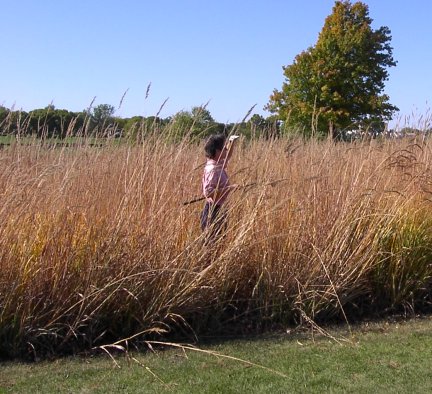 If the provisional
ball lies short of the original ball and it is necessary for you to hit
it a second time before reaching the original ball for the search, then
do so under no penalty. However, do not hit the provisional ball
if it lies at or ahead of where the original ball was lost, before the
search for the original ball. This would immediately make the
original ball deemed lost and you must continue play with the
provisional ball under penalty of one stroke and loss of
distance.
If the provisional
ball lies short of the original ball and it is necessary for you to hit
it a second time before reaching the original ball for the search, then
do so under no penalty. However, do not hit the provisional ball
if it lies at or ahead of where the original ball was lost, before the
search for the original ball. This would immediately make the
original ball deemed lost and you must continue play with the
provisional ball under penalty of one stroke and loss of
distance.
So, after getting in there and letting myself know how displeased I was
with myself for putting my ball in such an unfriendly place, I started
thinking, what are my options.
First, I have not been able to locate the ball yet. Plus I can
not even imagine hitting the ball from this tall grass. So lets
use the rules to our advantage.
I can tell my playing partners, who are likely helping me to find my
ball, that I am suspending the search and that I declare the ball
lost. At that point, everyone should discontinue the
search. Because if someone does locate it then it IS still
considered the live ball and I am REQUIRED to play that ball. The
provisional ball at this point must be picked up and you MUST play the
fescue ball.
Second, lets say you find the ball and do not want to play from this
unfriendly area. You must now declare your ball "Unplayable" and
the rules for unplayable balls are invoked.
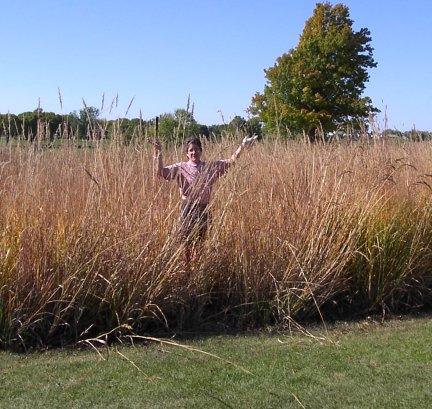
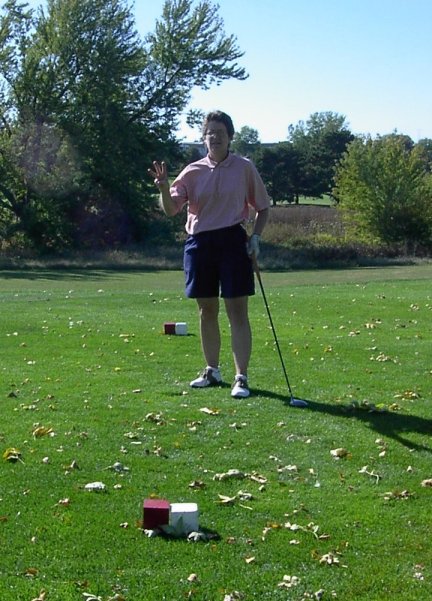 If a player deems
her ball unplayable a penalty of one stroke will be incurred. The
next shot will be played under one of the following options:
If a player deems
her ball unplayable a penalty of one stroke will be incurred. The
next shot will be played under one of the following options:
a) play the next shot as near as possible to the spot the
original ball was struck. In our case, I would have to return to
the tee box and rehit the tee shot and be hitting my third shot.
Or since I have already hit a provisional, I can declare that to be my
live ball and take the stroke and distance penalty at that point.
b) drop a ball within two club-lengths of the spot where I found
the ball, but no closer to the hole. This means that if I'm deep
enough in the fescue and two club-lengths do not get me out then I
would have to keep dropping and adding strokes until I get out.
May not be a great option in that case.....some of these fescue patches
are very wide. So think these situation through.
c) drop a ball behind the point where the ball lies, keeping that
point directly between the hole and the spot on which the ball is
dropped. Basically if you drew a straight line from the flag
through the ball in the fescue and back behind, then anywhere along
that line behind the spot in the fescue is fair ground to make your
drop. There is no limit to how far back you go as long as the
spot keeps the original position in the fescue between you and the
pin.
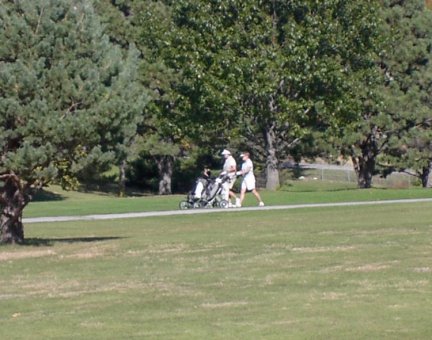
Once you have completed your drop, discuss it with your playing partner
and make sure that you record the correct score for the hole.
Errors at this point can be devastating if you end up signing an
incorrect scorecard. The rules are a part of the game of golf and
if you know your options, these rules can actually help you at times
such as these.
So know your options. And I hope NO ONE ever finds themselves in
these darn fescue grasses because you'll itch for the next few
weeks. Ugh What we do for this great game!!!



 My
ball has come to rest within a "ground under repair" marked area. I
have a few options but a few issues
need to be addressed. First, I must take FULL relief from the area.
What do we mean by FULL relief? Not only does the ball need to be
removed from the area with a drop but when I take my stance after the
drop, no part of my body (feet in particular) can be touching the area.
This is one area where
we do not have the option to play it even if we want to. We MUST
take a drop.
My
ball has come to rest within a "ground under repair" marked area. I
have a few options but a few issues
need to be addressed. First, I must take FULL relief from the area.
What do we mean by FULL relief? Not only does the ball need to be
removed from the area with a drop but when I take my stance after the
drop, no part of my body (feet in particular) can be touching the area.
This is one area where
we do not have the option to play it even if we want to. We MUST
take a drop. 


 a) Grounding your club in a
trap is a no no. Doing so will be a two stroke penalty in Stroke Play.
a) Grounding your club in a
trap is a no no. Doing so will be a two stroke penalty in Stroke Play. 




 Have you ever come upon your shot in the
fairway and found one of the distance markers so close to your ball
that
you can not take proper stance for the next shot? Here was just
a case when the 100 yard stake kept me from taking a normal stance
for my shot.
Have you ever come upon your shot in the
fairway and found one of the distance markers so close to your ball
that
you can not take proper stance for the next shot? Here was just
a case when the 100 yard stake kept me from taking a normal stance
for my shot. 





 Once the ball has come to rest
on the green, you must place a marker behind the ball when it has
finally come to rest on the green. But do not touch the ball until you
have placed your mark behind the ball. Then and only then can you lift
your ball.
Once the ball has come to rest
on the green, you must place a marker behind the ball when it has
finally come to rest on the green. But do not touch the ball until you
have placed your mark behind the ball. Then and only then can you lift
your ball. Here we see
the player placing their marker behind the ball BEFORE they have lifted
the ball. Once it is in place the
player can legally lift and clean their ball.
Here we see
the player placing their marker behind the ball BEFORE they have lifted
the ball. Once it is in place the
player can legally lift and clean their ball.




 If the provisional
ball lies short of the original ball and it is necessary for you to hit
it a second time before reaching the original ball for the search, then
do so under no penalty. However, do not hit the provisional ball
if it lies at or ahead of where the original ball was lost, before the
search for the original ball. This would immediately make the
original ball deemed lost and you must continue play with the
provisional ball under penalty of one stroke and loss of
distance.
If the provisional
ball lies short of the original ball and it is necessary for you to hit
it a second time before reaching the original ball for the search, then
do so under no penalty. However, do not hit the provisional ball
if it lies at or ahead of where the original ball was lost, before the
search for the original ball. This would immediately make the
original ball deemed lost and you must continue play with the
provisional ball under penalty of one stroke and loss of
distance. 
 If a player deems
her ball unplayable a penalty of one stroke will be incurred. The
next shot will be played under one of the following options:
If a player deems
her ball unplayable a penalty of one stroke will be incurred. The
next shot will be played under one of the following options: